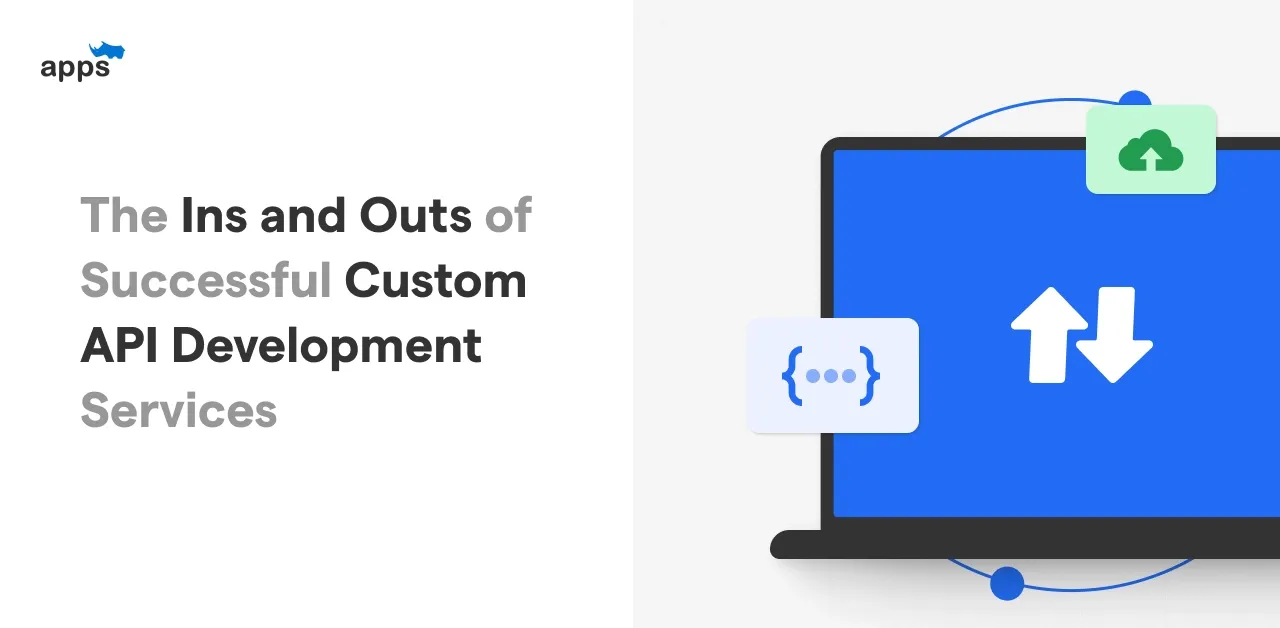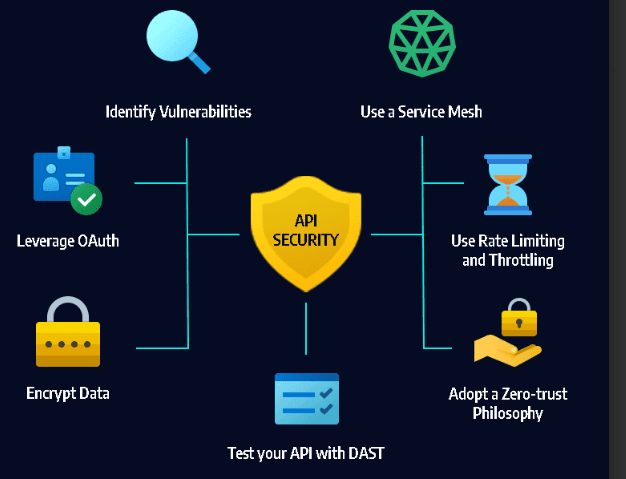- Understanding APIs
- The Custom API Development Process
- Key Factors for Successful Custom API Development
- API Security Best Practices
- Maintaining and Monitoring APIs
- Conclusion
- Frequently Asked Questions (FAQs)
Table of Contents
The Ins and Outs of Successful Custom API Development Services

Custom API Development Services are gaining popularity in the world of software and application development for their versatility and usability. With the help of custom API development, your business can stay ahead of its competitors by streamlining workflows.
API makes sure there is constant and uninterrupted data flow and that too safely and securely.
By hiring a custom API development company you can make sure that they can understand your business requirements and help you achieve your ultimate goals by integrating the API with multiple apps and systems which will help you save time and increase productivity and efficiency.
In this blog, we will explore the ins and outs of successful custom API development services, including the development process, key factors for success, API security best practices, and maintaining and monitoring APIs.
We'll also take a look at how businesses can benefit from custom APIs and what the future holds for this growing field.
Understanding APIs

APIs, or Application Programming Interfaces, are tools used to enable communication and integration between different software applications.
They define a set of rules and protocols that applications can use to interact with each other. APIs allow developers to access and utilize the functionality of existing software applications without having to build everything from scratch.
Types of APIs
There are different types of APIs, including web APIs, and library APIs
- Web APIs are mainly used for web applications purposes. These APIs are demonstrated using JSON and XML files. Many organizations, companies, and even government agencies heavily rely on web APIs for the easy accessibility of data.
- Library APIs as the name suggests, is a collection of several APIs which you can access and incorporate into your task as per your need. It contains pre-written code or functions that can be accessed externally.
Benefits of Using APIs
APIs have become an integral part of modern software development, and their usage continues to expand across various industries. The benefits of using APIs in custom software development are numerous.
- Using API you can enhance the incorporation among different software applications. This also increases the chance of code reusability.
- API promotes faster development by utilizing existing functions that facilitate collaboration between development teams and promote scalability.
- API also promotes the security of the data and information shared through encryption methods.
The Custom API Development Process

Developing a custom API involves a systematic process that includes several key steps. By following this process, developers can create robust and successful custom APIs that meet the specific needs of their clients.
Step 1
Analyzing Requirements
Before building a custom API, it's essential to thoroughly understand the client's requirements and objectives.
This involves gathering information about the desired functionality, the input and output data, and any specific integration needs. Analyzing these requirements ensures that the API will provide the expected features and meet the client's expectations.
Step 2
Designing the API
API design plays a crucial role in the success of custom API development. During this phase, developers define the various endpoints, methods, and payload structures that the API will support.
It is important to design a clean and intuitive API architecture that is easy to understand and use by client applications.
Step 3
API Development
Once the API design is finalized, developers proceed with the implementation. They write code to create the necessary endpoints, handle requests and responses, and manage data flow.
It's crucial to choose the right technology stacks and development tools for building the API to ensure scalability, performance, and maintainability.
Step 4
API Testing
Thorough testing is essential to ensure the reliability and functionality of the custom API. This includes unit testing, integration testing, and system testing.
It's important to test the API under various scenarios, including positive and negative data inputs, to ensure that it behaves as expected and handles errors gracefully.
Step 5
API Documentation
Proper documentation is crucial for the successful adoption and usage of the custom API. The documentation should provide a clear and concise explanation of each API endpoint, its parameters, expected responses, and any authentication requirements.
A well-documented API makes it easier for developers to integrate with the API and helps minimize errors and misunderstandings.
Key Factors for Successful Custom API Development
To ensure the success of custom API development, several key factors need to be considered. These factors focus on aspects such as security, scalability, error handling, and compatibility.
Security and Authentication

API security is of utmost importance to protect sensitive data and prevent unauthorized access.
This involves implementing secure authentication mechanisms, such as token-based authentication or OAuth, and applying role-based access control (RBAC) to restrict access to specific API resources.
Scalability and Performance
Successful custom APIs need to be designed with scalability in mind to handle increasing traffic and evolving business requirements.
Techniques like load balancing, caching, and horizontal scaling can be employed to ensure optimal performance and responsiveness, even under high loads.
Error Handling and Exception Management
Effective error handling is crucial for APIs to provide meaningful feedback to client applications. APIs should return appropriate error codes and messages when a request fails, aiding in debugging and troubleshooting.
Exception management should be implemented to gracefully handle and recover from unexpected errors or exceptions.
Versioning and Compatibility
As APIs evolve, managing versioning and maintaining backward compatibility whenever possible is essential. Proper versioning allows for introducing new features while still supporting older versions of the API.
Developers should communicate changes and deprecations effectively to ensure a smooth transition for client applications.
API Integration and Third-Party Support
Custom APIs often need to be integrated with existing software systems or third-party APIs. This integration enables businesses to leverage the functionalities and data available in these systems.
Developers need to ensure seamless integration by adhering to the specifications and requirements of the external systems or APIs, allowing for efficient data exchange and collaboration.
APIs can also be designed to be consumed by external developers as public APIs, enabling third-party developers to build applications on top of the provided functionalities. This can open up new business opportunities and foster innovation through the developer community.
API Security Best Practices

When developing custom APIs, following security best practices is crucial to protect data and ensure the integrity of the system.
Data Encryption and Secure Transmission
Sensitive data should be encrypted both at rest and during transmission. Encryption algorithms such as AES (Advanced Encryption Standard) can be used to protect data from unauthorized access.
Secure communication protocols like HTTPS should be employed to encrypt data in transit, reducing the risk of interception or tampering.
Input Validation and Sanitization
Proper input validation and sanitization help prevent common security vulnerabilities like SQL injection and cross-site scripting attacks.
All user inputs should be validated and sanitized to remove any potentially harmful or malicious content.
Access Control and Authorization
To maintain the confidentiality and integrity of data, access control and authorization mechanisms should be implemented. This ensures that only authorized users or applications can access specific API resources or perform certain actions.
Role-based access control is commonly used to grant or restrict access based on user roles or permissions.
Suggested Reading:
How to Select the Best Tools for Custom API Development?
Maintaining and Monitoring APIs
Once a custom API is deployed and in use, it's essential to maintain and monitor its performance, availability, and security.
API Versioning and Backward Compatibility
Adhering to versioning best practices ensures that updates and new features can be introduced while still supporting older versions.
This can be taken care of using proper communication and documentation of version changes minimizing disruption and supporting backward compatibility.
Performance Monitoring and Optimization
Continuous monitoring of API’s response times, resource usage, and potential bottlenecks can make sure their performance is at an optimal level.
This monitoring allows for proactive optimization, such as scaling resources, caching frequently accessed data, or identifying and resolving performance bottlenecks.
Error and Log Monitoring
Monitoring API errors and logs helps in identifying issues, analyzing trends, and resolving potential problems proactively.
Effective log monitoring allows developers to gain insights into the API's behavior and take corrective actions promptly.
Conclusion
To wrap up, custom API development has become an integral part of modern software development, facilitating communication and integration between different applications.
Creating successful custom APIs requires a systematic development process, including understanding client requirements, designing the API, implementing it, testing it thoroughly, and properly documenting it.
Factors such as security, scalability, and backward compatibility are crucial for creating reliable, secure, and developer-friendly custom APIs.
As APIs continue to gain popularity across various industries, mastering the ins and outs of custom API development services has become a valuable skill for software developers.
Frequently Asked Questions (FAQs)
What is the role of APIs in custom software development?
APIs enable communication and integration between software applications, allowing developers to access and utilize existing functionalities without starting from scratch.
What are the key factors for successful custom API development?
Key factors include security and authentication, scalability and performance, error handling, and versioning and compatibility.
How can I ensure the security of my custom API?
Ensure input validation and sanitization, implement access control and authorization mechanisms, and encrypt sensitive data both at rest and during transmission.
Why is API documentation important?
API documentation provides clear explanations of endpoints, parameters, responses, and authentication requirements, making it easier for developers to integrate with the API and minimize errors.
How do I maintain and monitor my custom API?
Maintain versioning and backward compatibility, monitor performance and optimize as needed, and monitor errors and logs for proactive issue resolution.
Table of Contents
- Understanding APIs
- The Custom API Development Process
- Key Factors for Successful Custom API Development
- API Security Best Practices
- Maintaining and Monitoring APIs
- Conclusion
- Frequently Asked Questions (FAQs)




